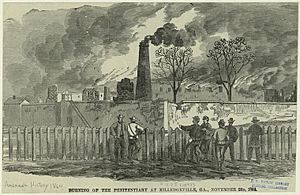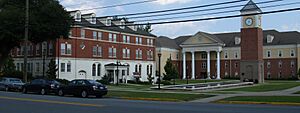Milledgeville, Georgia facts for kids
Quick facts for kids
Milledgeville, Georgia
|
|||
|---|---|---|---|
| City of Milledgeville | |||
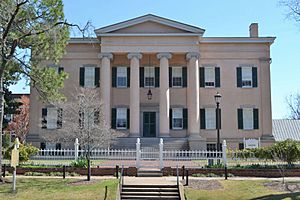
|
|||
|
|||
| Motto(s):
"Capitols, Columns and Culture"
|
|||
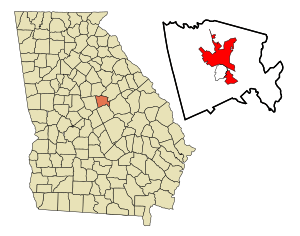
Location in Baldwin County and the state of Georgia
|
|||
| Country | |||
| State | |||
| County | Baldwin | ||
| Incorporated | December 12, 1804 | ||
| Named for | John Milledge | ||
| Government | |||
| • Type | Council–Manager | ||
| Area | |||
| • Total | 20.48 sq mi (53.05 km2) | ||
| • Land | 20.32 sq mi (52.63 km2) | ||
| • Water | 0.16 sq mi (0.42 km2) | ||
| Elevation | 330 ft (100 m) | ||
| Population
(2020)
|
|||
| • Total | 17,070 | ||
| • Density | 839.98/sq mi (324.31/km2) | ||
| Time zone | UTC−5 (Eastern Time) | ||
| • Summer (DST) | UTC−4 (EDT) | ||
| ZIP Code |
31061
|
||
| Area code | 478 | ||
| FIPS code | 13-51492 | ||
| GNIS feature ID | 0332390 | ||
Milledgeville is a city in Georgia, USA. It is the main city of Baldwin County. The city is located northeast of Macon. It is bordered on the east by the Oconee River. The river's fast current made this a good place to build a city.
Milledgeville was the capital of Georgia from 1804 to 1868. This period included the American Civil War. Before Milledgeville, Louisville was the capital. After Milledgeville, Atlanta became the capital, and it still is today. U.S. Highway 441 connects Milledgeville to other cities like Madison, Athens, and Dublin.
In 2020, Milledgeville had a population of 17,070 people. This was a small decrease from 17,715 people in 2010.
Milledgeville is on the Fall Line Freeway. This road links it to other historic cities like Augusta, Macon, and Columbus. These cities are all located along the Fall Line.
Milledgeville is the main city of the Milledgeville micropolitan area. This area includes Baldwin County. In 2020, its population was 43,799. The Old State Capitol building is in Milledgeville. It is listed on the National Register of Historic Places. Much of the old city is part of the Milledgeville Historic District. This district is also on the National Register.
Contents
History of Milledgeville
Milledgeville was named after Georgia governor John Milledge. He was governor from 1802 to 1806. European Americans founded the city in the early 1800s. They wanted a new capital city that was more central for Georgia. It served as the state capital from 1804 to 1868.
In 1803, Georgia's government decided to create a new town. They wanted to name it after Governor John Milledge. Native American tribes had recently given up land west of the Oconee River. More white settlers in Georgia were moving west and south. They were looking for new farmland. Milledgeville was built in an area where Native American people had lived for a long time.
By December 1804, Milledgeville was declared the new capital of Georgia. This new city was planned like Savannah and Washington, D.C.. It was on the edge of the frontier. This area is where the flat Coastal Plain meets the hills of the Piedmont. Surveyors measured out the area. They divided 500 acres into 84 squares, each about 4 acres. They also included four public squares, each 20 acres.
Life Before the Civil War
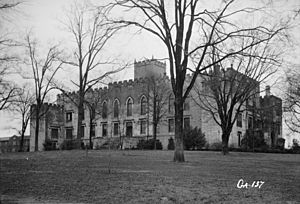
After 1815, Milledgeville grew richer and more respected. Wealth and power came to the capital city. Much of the land around the city became cotton plantations. Enslaved people were forced to work on these plantations. Cotton was the main crop of the South. Bales of cotton often lined the roads. They were waiting to be shipped down the river to Darien.
Leaders like Mayor Tomlinson Fort (1847–1848) helped improve the city. They supported better newspapers, schools, and banks. In October 1842, Central State Hospital was built here. Oglethorpe University opened in 1838. The famous poet Sidney Lanier studied there. The college closed in 1862 during the war. It reopened in Atlanta in 1913.
The huge growth of cotton farming increased the need for enslaved workers. The town market was on Capital Square, next to the Presbyterian church. This is where enslaved people were sold. Skilled Black carpenters, masons, and laborers were forced to build many of Milledgeville's beautiful old buildings.
Two big events showed Milledgeville's importance in Georgia:
- In March 1825, the city welcomed American Revolutionary War hero Marquis de Lafayette. There were parties, a barbecue, and a grand ball. This event showed Milledgeville was becoming a major city.
- The Governor's Mansion was built in 1839. It is a great example of Greek Revival architecture in America.
By 1854, Baldwin County had 8,148 people. About 3,566 were free people, mostly white. The other 4,602 were enslaved African Americans.
The Civil War and After
On January 19, 1861, Georgia's leaders decided to leave the United States. On February 4, 1861, Georgia joined the Confederate States of America. In November 1864, Union General William T. Sherman marched into Milledgeville. He had 30,000 Union soldiers with him during his March to the Sea. Governor Joseph E. Brown had already left town. He took rugs and curtains from the Governor's Mansion. Other leaders also fled, leaving the public without protection. Sherman mostly saved the town from being destroyed. However, he did burn some buildings that had military uses. It is said that Sherman's troops poured syrup into the organ pipes at St. Stephen's Episcopal Church. The organ was later replaced.
In July 1868, during the Reconstruction period, the state capital moved to Atlanta. Atlanta was seen as a symbol of the "New South." Milledgeville was seen as a symbol of the "Old South."
Milledgeville struggled after losing its status as the capital. Local leaders worked hard to help the city. They started the Middle Georgia Military and Agricultural College in October 1879. This school is now Georgia Military College. Where the old prison used to be, the Georgia Normal and Industrial College was founded in November 1889. This school is now Georgia College & State University. These schools, along with Central State Hospital, helped Milledgeville grow. It became a more modern town than many nearby places.
Recent History
In 1952, the Georgia Power Company built a dam on the Oconee River. This created a large lake called Lake Sinclair. The lake community became very important to the city's social and economic life.
In the 1980s and 1990s, Milledgeville started to focus on its history. The downtown and historic district were improved. People were encouraged to restore old buildings. The city also made changes to Main Street to highlight its historic feel.
By 2000, the population of Milledgeville and Baldwin County reached almost 45,000. City leaders have worked to create different types of jobs. They want the city to rely less on government places like Central State Hospital and state prisons. Recently, the state has closed some prisons. It has also reduced jobs at Central State due to budget cuts.
Geography and Location
Milledgeville is located at 33°5′16″N 83°14′0″W / 33.08778°N 83.23333°W. It is about 330 feet (100 meters) above sea level.
The city covers about 53.3 square kilometers (20.6 square miles). Most of this area is land, about 52.9 square kilometers (20.4 square miles). A small part, 0.4 square kilometers (0.16 square miles), is water.
U.S. Route 441 is the main road through Milledgeville. It goes north to Eatonton (21 miles) and south to Irwinton (22 miles). Other state roads like GA-22, GA-24, and GA-49 also pass through the city.
Milledgeville is on the Atlantic Seaboard fall line. The Oconee River flows about half a mile east of downtown. It continues south to the Altamaha River and then to the Atlantic Ocean. Lake Sinclair, a lake made by people, is about 5 miles northeast of Milledgeville. It is on the border of Baldwin, Putnam, and Hancock counties.
Milledgeville has two main areas. One is a busy shopping area along Highway 441. Locals call it "441." It stretches north of Georgia College & State University. The other area is "Downtown." This historic area includes the college, government buildings, and many shops and restaurants. It was planned in 1803, with streets named after other counties in Georgia.
Climate
Milledgeville has a warm climate. Summers are hot and humid. Winters are mild. The hottest months are July and August, with average highs around 91-92°F (33°C). The coldest months are January and December, with average highs around 58°F (14°C). The city gets a good amount of rain throughout the year.
Population Information
| Historical population | |||
|---|---|---|---|
| Census | Pop. | %± | |
| 1810 | 1,256 | — | |
| 1820 | 2,069 | 64.7% | |
| 1840 | 2,095 | — | |
| 1850 | 2,216 | 5.8% | |
| 1860 | 2,480 | 11.9% | |
| 1870 | 2,750 | 10.9% | |
| 1880 | 3,800 | 38.2% | |
| 1890 | 3,322 | −12.6% | |
| 1900 | 4,219 | 27.0% | |
| 1910 | 4,385 | 3.9% | |
| 1920 | 4,619 | 5.3% | |
| 1930 | 5,534 | 19.8% | |
| 1940 | 6,778 | 22.5% | |
| 1950 | 8,835 | 30.3% | |
| 1960 | 11,117 | 25.8% | |
| 1970 | 11,601 | 4.4% | |
| 1980 | 12,176 | 5.0% | |
| 1990 | 17,727 | 45.6% | |
| 2000 | 18,757 | 5.8% | |
| 2010 | 17,715 | −5.6% | |
| 2020 | 17,070 | −3.6% | |
| U.S. Decennial Census | |||
| Race | Num. | Perc. |
|---|---|---|
| White (non-Hispanic) | 8,055 | 47.19% |
| Black or African American (non-Hispanic) | 7,685 | 45.02% |
| Native American | 23 | 0.13% |
| Asian | 280 | 1.64% |
| Pacific Islander | 16 | 0.09% |
| Other/Mixed | 456 | 2.67% |
| Hispanic or Latino | 555 | 3.25% |
As of the 2020 United States census, there were 17,070 people living in Milledgeville. There were 5,895 households and 2,852 families in the city.
Education in Milledgeville
The public schools in Milledgeville are managed by the Baldwin County School District.
Public Elementary Schools
- Lakeview Academy
- Lakeview Primary
- Midway Hills Academy
- Midway Hills Primary
Public Middle School
- Oak Hill Middle School
Public High School
- Baldwin High School
Private Schools
- Georgia Military College prep school (grades K–12)
- John Milledge Academy (grades K–12)
Colleges and Universities
- Central Georgia Technical College
- Georgia College & State University (often called Georgia College)
- Georgia Military College
Libraries
Milledgeville's public library is part of the Middle Georgia Regional Library System. The Mary Vinson Memorial Library is located downtown. Georgia College & State University also has its own library.
Transportation
Main Roads
Walking and Biking Paths
- Oconee River Greenway
Famous People from Milledgeville
- Melvin Adams, Jr (Fish Scales from Nappy Roots)
- Andrew J. Allen, concert saxophonist
- Nathan Crawford Barnett, Georgia Secretary of State
- Ella Barksdale Brown, journalist and educator
- Kevin Brown, professional baseball player
- Javon Bullard, college football player
- Tasha Butts, basketball player and coach
- Wally Butts, college football coach
- Earnest Byner, professional football player
- Lisa D. Cook, American economist
- Pete Dexter, novelist and journalist
- George Doles, Confederate General
- Henry Derek Elis, singer for Act of Defiance
- Tillie K. Fowler, politician
- Joel Godard, television announcer
- Marjorie Taylor Greene, US Representative
- Willie Greene, professional baseball player
- Floyd Griffin, former mayor and state politician
- Oliver Hardy, famous comedian
- Nick Harper, professional football player
- Charles Holmes Herty, scientist and football coach
- Leroy Hill, professional football player
- Maurice Hurt, professional football player
- Edwin Francis Jemison, Civil War soldier
- Sherrilyn Kenyon, author
- Grace Lumpkin, writer
- William Gibbs McAdoo, US Secretary of the Treasury
- David Brydie Mitchell, former Georgia Governor
- Celena Mondie-Milner, professional track and field athlete
- Powell A. Moore, politician
- Otis Murphy, saxophone soloist and professor
- Flannery O'Connor, famous author
- Ulrich Bonnell Phillips, historian
- Barry Reese, writer
- Lucius Sanford, professional football player
- Carrie Bell Sinclair, poet
- Tut Taylor, bluegrass musician
- Ellis Paul Torrance, psychologist
- Larry Turner, professional basketball player
- William Usery Jr., labor activist and US Secretary of Labor
- Carl Vinson, congressman
- J. T. Wall, professional football player
- Rico Washington, professional baseball player
- Rondell White, professional baseball player
- Robert McAlpin Williamson, Texas Supreme Court Justice
See also
 In Spanish: Milledgeville (Georgia) para niños
In Spanish: Milledgeville (Georgia) para niños





